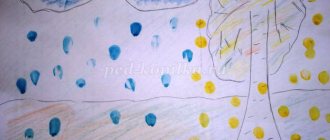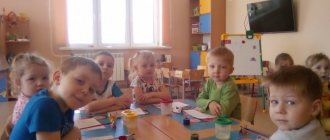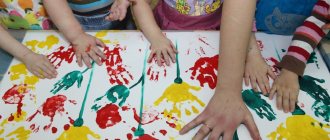Methods and techniques for teaching drawing to preschool children
Methods and techniques for teaching drawing to preschool children
The development of the creative potential of a child’s personality occurs in various types of visual activities and is carried out from early childhood. A preschooler, under the guidance of a teacher, masters the process of creating an image. It is in the visual arts that children develop aesthetic feelings, taste, ideas, and develop the ability to perceive the beauty of the surrounding life, nature, and art.
Drawing is an interesting and useful activity. This is one of the favorite activities of children, giving great scope for the manifestation of their creative activity. The themes of the drawings can be varied. Children draw everything, it interests them: individual objects and scenes from the surrounding life, literary characters, and so on. In the process of drawing, in a variety of ways using a variety of materials, pictorial and graphic images are created. Introducing children to the world of beauty develops creativity (the creative beginning of the individual), forms aesthetic taste, and allows them to feel the harmony of the world around them. Drawing has an element of psychotherapy - it calms, distracts, and occupies. It is important and necessary to develop the child’s ability to perceive the world figuratively and come up with new stories. With skillful organization of classes and taking into account the psychological and physiological characteristics of children, drawing can become one of the favorite activities of children.
In early preschool age, the tasks of teaching visual skills are in the foreground. To teach the depiction of various and circular shapes of simple objects, conveying their main characteristics (color, shape). Develop compositional skills - position the image in the middle of a sheet of paper, improve technical skills. By mastering the outlines of the simplest pictorial forms, using bright, colorful tones, children learn to find similarities with objects of the surrounding reality. They begin to realize the visual capabilities of materials and independently use the acquired skills when depicting other objects.
The development of visual activity has two goals. Firstly, enriching the child’s cognitive and aesthetic experience in the process of becoming familiar with the surrounding reality, and secondly, clarifying ideas about various objects. Children's experience gradually expands in the process of all auxiliary work in classes, walks, excursions, etc. These perceptions may be related to the task of the subsequent image, but may also have other purposes. It is important that the teacher takes them into account during drawing classes. The accumulation of impressions about the environment is the basis for conducting classes in visual arts. Perception of the environment must be purposeful. The child must clearly understand what and why he needs to observe. Sometimes individual methods can act as only a technique and not determine the direction of work in the lesson as a whole. For example, if reading a poem (story) at the beginning of a lesson is precisely the goal of simply arousing interest in the task and attracting the attention of children, then in this case reading served as a technique to help the teacher in solving the problem of organizing the beginning of the lesson.
In kindergarten, visual arts classes use a variety of methods and techniques, which can be roughly divided into: visual and verbal. The observation method underlies the entire system of teaching fine arts. The success of the development of their creative abilities depends on how well children develop their ability to observe, establish connections between phenomena of reality, and identify the general and the individual. The child must know, see and feel the object or phenomenon that he is going to depict. Children should have clear and clear ideas about objects and phenomena. There are many visual aids used in drawing classes. They are all accompanied by verbal explanations.
One of the effective methods of visual teaching is the teacher’s drawing. But the drawing must be graphically literate, not simplified. The image should be kept alive, corresponding to the real object. For example, when showing how to draw a Christmas tree, the teacher must proceed from the requirements of the program for a given age - convey the main features: a vertical trunk, green branches going to the sides. The visual image from the drawing should not diverge from the image of the real object, then the correct image will be preserved in the children’s memory.
Children follow the teacher’s drawing and begin to imitate him. Imitation plays an active teaching role. Children who watch how a drawing is created develop the ability to see the features of shape and color in their planar image. But in order to develop the ability to think independently, depict, and freely use acquired skills, imitation alone is not enough. Therefore, the methods of teaching children are consistently becoming more complex.
V.N. Avanesova in her work recommends the gradual involvement of children in the joint process of drawing with the teacher, when the child completes the work he has begun - draws strings to drawn balls, stems to flowers, sticks to flags, etc. She suggests that the child first learn to recognize the object being depicted, analyze already drawn and missing parts, practice drawing lines (of various types), receiving joy and emotional pleasure from the result of his work.
You can use demonstrations of drawing techniques and verbal explanation, and children will complete the task themselves without a reference drawing. For this, it is important that the process of constructing a drawing by the teacher’s hand is well coordinated with the course of verbal presentation. The teacher supports his explanation with visual material, thereby helping the child analyze what he saw, understand it, and better remember the task. The youngest preschooler has not yet developed enough memory, the ability to retain for a long time, perceived with clarity (in this case, this is the teacher’s explanation): he either remembers only part of the instructions and performs the task incorrectly, or he cannot start anything without a repeated explanation. Therefore, the teacher must once again explain the task to each child.
The result of a small child’s activity in painting with paints is a bright spot. The teacher must help the child understand that the color in the drawing exists to recreate the image. When working with paints, we must ensure that children strive to improve their resemblance to objects. First of all, children need to be taught the rules of handling paints and brushes.
The use of various game moments has a positive impact on the learning of children of primary preschool age. When the teacher uses game situations, the objects in the image become closer, more lively and interesting. The use of game moments in the process of visual activity refers to visual and effective teaching methods. The smaller the child, the more place play should occupy in his upbringing. Playful teaching methods will stimulate children to the assigned task and facilitate the work of thinking and imagination. In early preschool age, learning to draw begins with play exercises. The purpose of the game exercises is to make the process of creating the simplest linear shapes and developing hand movements more effective. Children, following the teacher, first draw various lines in the air with their hand, then with their finger on the paper, supplementing the movements with an explanation: “A boy is running along the path,” “This is how a grandmother shakes a ball,” etc. The combination of image and movement in a game situation accelerates the acquisition of the ability to depict lines and simple forms. The teacher uses the desire to play to increase the desire to draw. The teacher can combine simple rhythmic strokes into a rug, then together with the children decorate the doll's corner with it. Collective work helps to develop children's interest in the drawings of their comrades and in drawing as an activity.
Playful moments in visual activities in the younger group continue when depicting objects. For example, a new doll comes to visit the children and they draw a dress for her. At the same time, the teacher should not turn the entire learning process into a game, since it can distract children from completing the educational task and disrupt the system in acquiring knowledge, skills and abilities.
Thus, the choice of certain methods and techniques depends on: the content and tasks facing this lesson, and on the tasks of visual activity;
- on the age of the children and their development;
- on the type of visual materials with which children operate
When teaching drawing to children of primary preschool age, play is actively used. An adult plays out the plot of the future drawing with the help of various toys and objects, accompanies the drawing with an emotional comment, uses poems, riddles, nursery rhymes, etc. This teaching method allows you to interest children and hold their attention longer. This creates the necessary emotional mood and a positive motive for activity. Often, the lack of skills makes kids angry and considers them; they give up trying to draw what they had planned. In this case, drawing may linger for a long time at the level of chaotic lines (scribbling, scribbles). When selecting games, the teacher must take into account the essential features of gaming methods and teaching techniques, the knowledge of younger preschoolers about the world around them, their interests and gaming experience, the tasks of directing visual activities and developing creativity, and didactic principles of teaching. The connection between visual activities and games serves to enrich and develop both types of activities. It also increases the interest of younger preschoolers in drawing, their emotional responsiveness, and promotes aesthetic and moral development.
Kids need to be given the opportunity to experiment. After the necessary skills have been developed in children and the drawing technique has been mastered, general classes are held in which children are given the opportunity to demonstrate their skills in creating original images. In addition to learning drawing skills, developing interest and a positive attitude towards visual activities, speech, imagination and creativity develop, and children get acquainted with the world around them. There is no need to force a child to draw if he does not want to. It is better not to insist on his participation; let him play or watch how other children work. If the atmosphere is relaxed and friendly, the children draw with interest: bright, attractive material will make the child want to participate in the common work. The lesson also ends not at the same time, but at the request of the children. Children who have weaker drawing skills should pay more attention during the lesson and encourage their desire to draw whenever they want. At this age, an individual approach is especially necessary, since it is here that children’s inclinations and abilities begin to form. Identifying them and developing them is one of the main educational goals.
The disposition to creativity is the highest manifestation of human activity, the ability to create something new, original, and to perform in any field of human activity. M.I. wrote about the importance of drawing for mental development. Kalinin: “A person who has learned and got used to drawing will have a special approach to each new subject. He will look at it from different angles, draw such an object, and he will already have an image in his head. This means that he will penetrate deeper into the very essence of the subject.”
Literature
1. Wenger L.A., Mukhina V.S. Psychology. – M.: Education, 1988. 2. Grigorieva G.G. “Visual activity of a preschooler” M. - 1997
3. Grigorieva G.G. “Game techniques in teaching preschoolers visual arts” M. “Prosveshcheniye” - 1995
4. Doronova T.N., S.G. Jacobson “Teaching children 2-4 years old to draw, sculpt, and apply in games” M. “Prosveshcheniye” - 1992
5. Komarova T.S. “Methodology for teaching visual arts and design” M. “Prosveshcheniye” - 1991
6. Komarova T.S., Sakkulina N.T. “Methods of teaching visual activity and design” M. “Prosveshcheniye” - 1979
7. Pogodina S.V. Theory and methods of development of children's visual creativity: Textbook. allowance for stud. avg. prof. textbook establishments /
8. Pogodina S.V. - M.: Publishing House, 2010. -




